Relevance of Flexible Working on Employee Performance: Starbucks Study
VerifiedAdded on 2020/07/22
|39
|12515
|30
Report
AI Summary
This report investigates the relevance of flexible working on employee performance, using Starbucks as a case study. The study explores the concept of flexible working, its importance, and its potential impact on employee performance levels. The research methodology includes a literature review, thematic analysis, and data analysis to assess the relationship between flexible working and employee outcomes. The findings highlight the benefits of flexible working, such as improved employee loyalty, reduced turnover, and enhanced productivity. Recommendations are provided for Starbucks regarding the appropriate adoption of flexible working arrangements. The report also addresses the limitations of the study, including time constraints and data availability. The structure of the dissertation includes an introduction, literature review, research methodology, data analysis, findings, and conclusion, providing a comprehensive overview of the topic and its implications for organizational management.
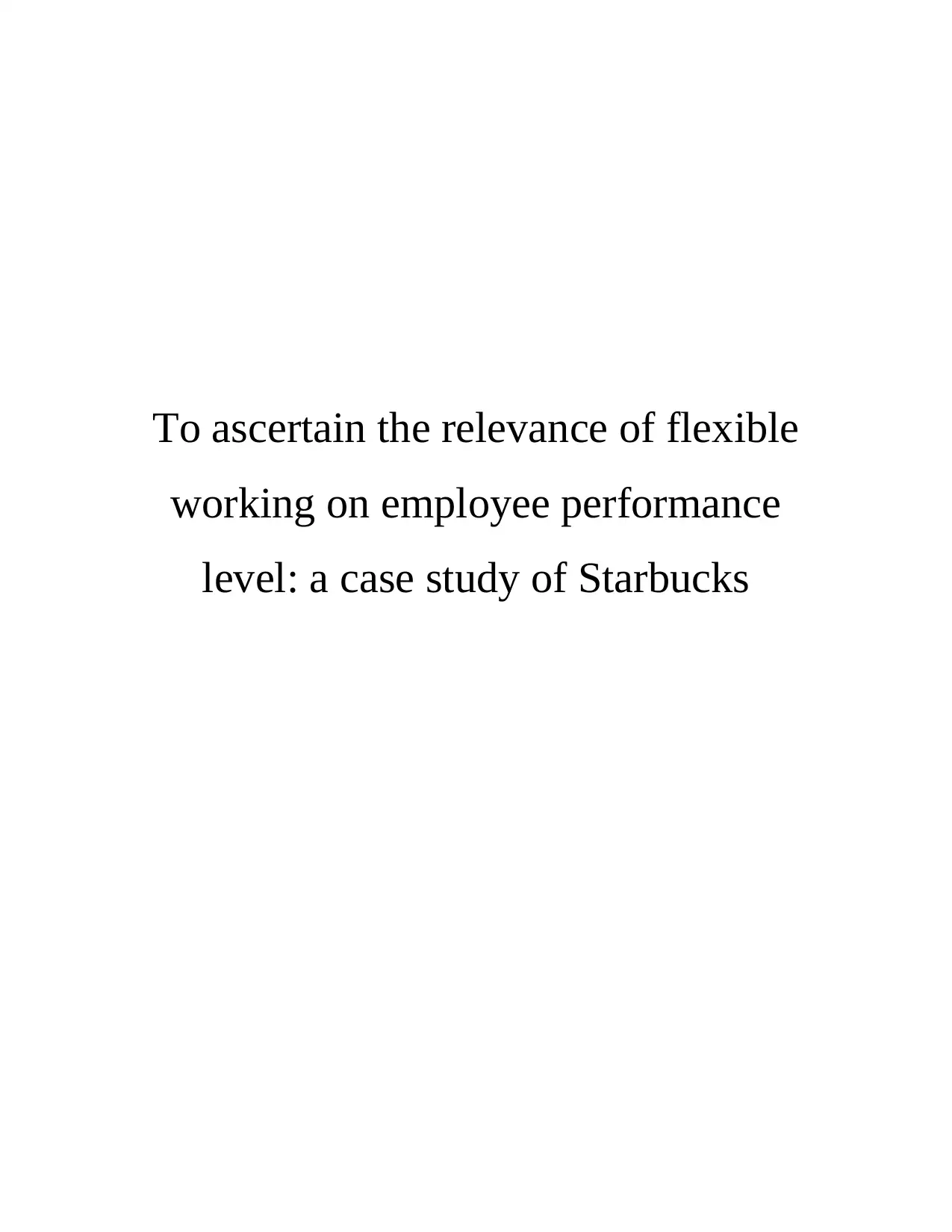
To ascertain the relevance of flexible
working on employee performance
level: a case study of Starbucks
working on employee performance
level: a case study of Starbucks
Paraphrase This Document
Need a fresh take? Get an instant paraphrase of this document with our AI Paraphraser
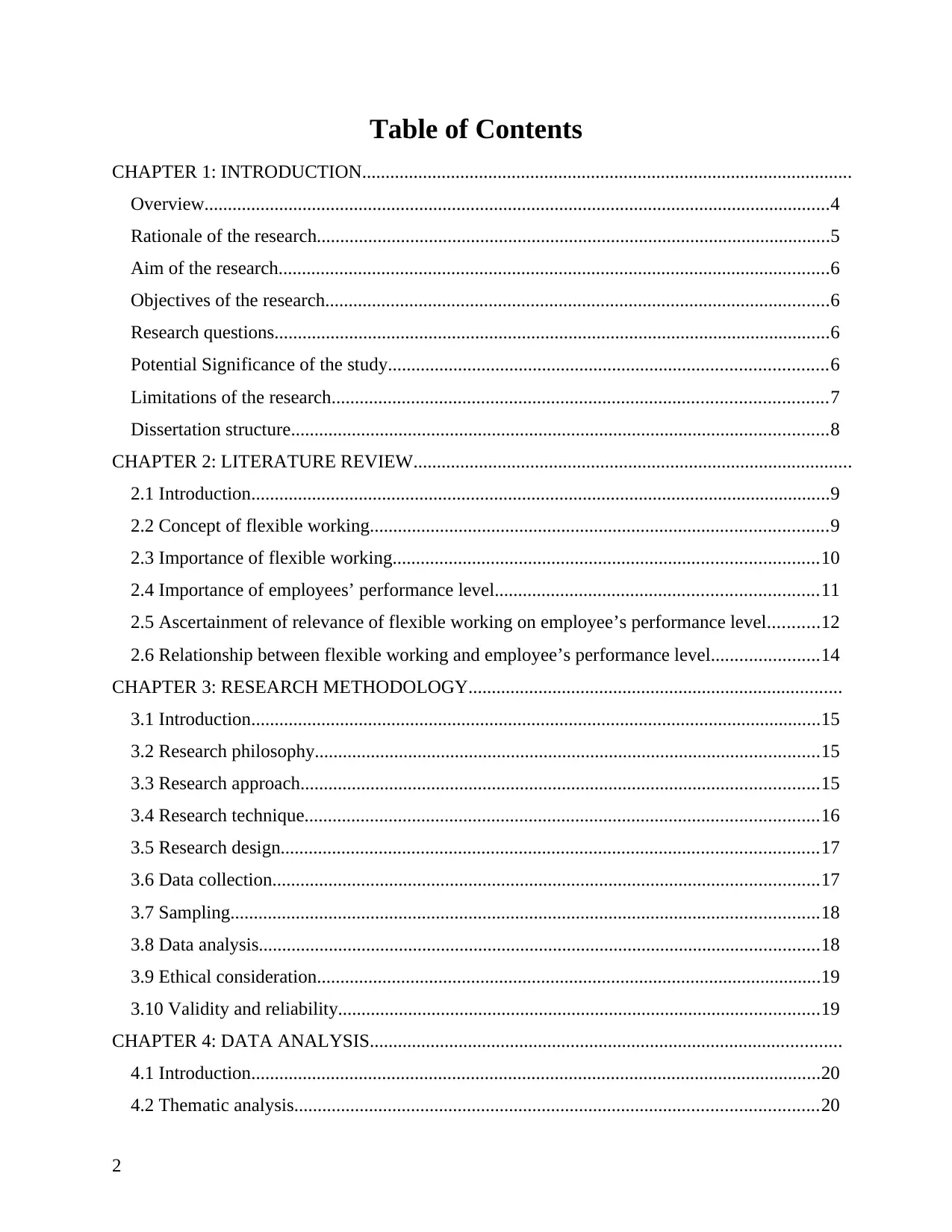
Table of Contents
CHAPTER 1: INTRODUCTION.........................................................................................................
Overview......................................................................................................................................4
Rationale of the research..............................................................................................................5
Aim of the research......................................................................................................................6
Objectives of the research............................................................................................................6
Research questions.......................................................................................................................6
Potential Significance of the study..............................................................................................6
Limitations of the research..........................................................................................................7
Dissertation structure...................................................................................................................8
CHAPTER 2: LITERATURE REVIEW..............................................................................................
2.1 Introduction............................................................................................................................9
2.2 Concept of flexible working..................................................................................................9
2.3 Importance of flexible working...........................................................................................10
2.4 Importance of employees’ performance level.....................................................................11
2.5 Ascertainment of relevance of flexible working on employee’s performance level...........12
2.6 Relationship between flexible working and employee’s performance level.......................14
CHAPTER 3: RESEARCH METHODOLOGY................................................................................
3.1 Introduction..........................................................................................................................15
3.2 Research philosophy............................................................................................................15
3.3 Research approach...............................................................................................................15
3.4 Research technique..............................................................................................................16
3.5 Research design...................................................................................................................17
3.6 Data collection.....................................................................................................................17
3.7 Sampling..............................................................................................................................18
3.8 Data analysis........................................................................................................................18
3.9 Ethical consideration............................................................................................................19
3.10 Validity and reliability.......................................................................................................19
CHAPTER 4: DATA ANALYSIS.....................................................................................................
4.1 Introduction..........................................................................................................................20
4.2 Thematic analysis................................................................................................................20
2
CHAPTER 1: INTRODUCTION.........................................................................................................
Overview......................................................................................................................................4
Rationale of the research..............................................................................................................5
Aim of the research......................................................................................................................6
Objectives of the research............................................................................................................6
Research questions.......................................................................................................................6
Potential Significance of the study..............................................................................................6
Limitations of the research..........................................................................................................7
Dissertation structure...................................................................................................................8
CHAPTER 2: LITERATURE REVIEW..............................................................................................
2.1 Introduction............................................................................................................................9
2.2 Concept of flexible working..................................................................................................9
2.3 Importance of flexible working...........................................................................................10
2.4 Importance of employees’ performance level.....................................................................11
2.5 Ascertainment of relevance of flexible working on employee’s performance level...........12
2.6 Relationship between flexible working and employee’s performance level.......................14
CHAPTER 3: RESEARCH METHODOLOGY................................................................................
3.1 Introduction..........................................................................................................................15
3.2 Research philosophy............................................................................................................15
3.3 Research approach...............................................................................................................15
3.4 Research technique..............................................................................................................16
3.5 Research design...................................................................................................................17
3.6 Data collection.....................................................................................................................17
3.7 Sampling..............................................................................................................................18
3.8 Data analysis........................................................................................................................18
3.9 Ethical consideration............................................................................................................19
3.10 Validity and reliability.......................................................................................................19
CHAPTER 4: DATA ANALYSIS.....................................................................................................
4.1 Introduction..........................................................................................................................20
4.2 Thematic analysis................................................................................................................20
2
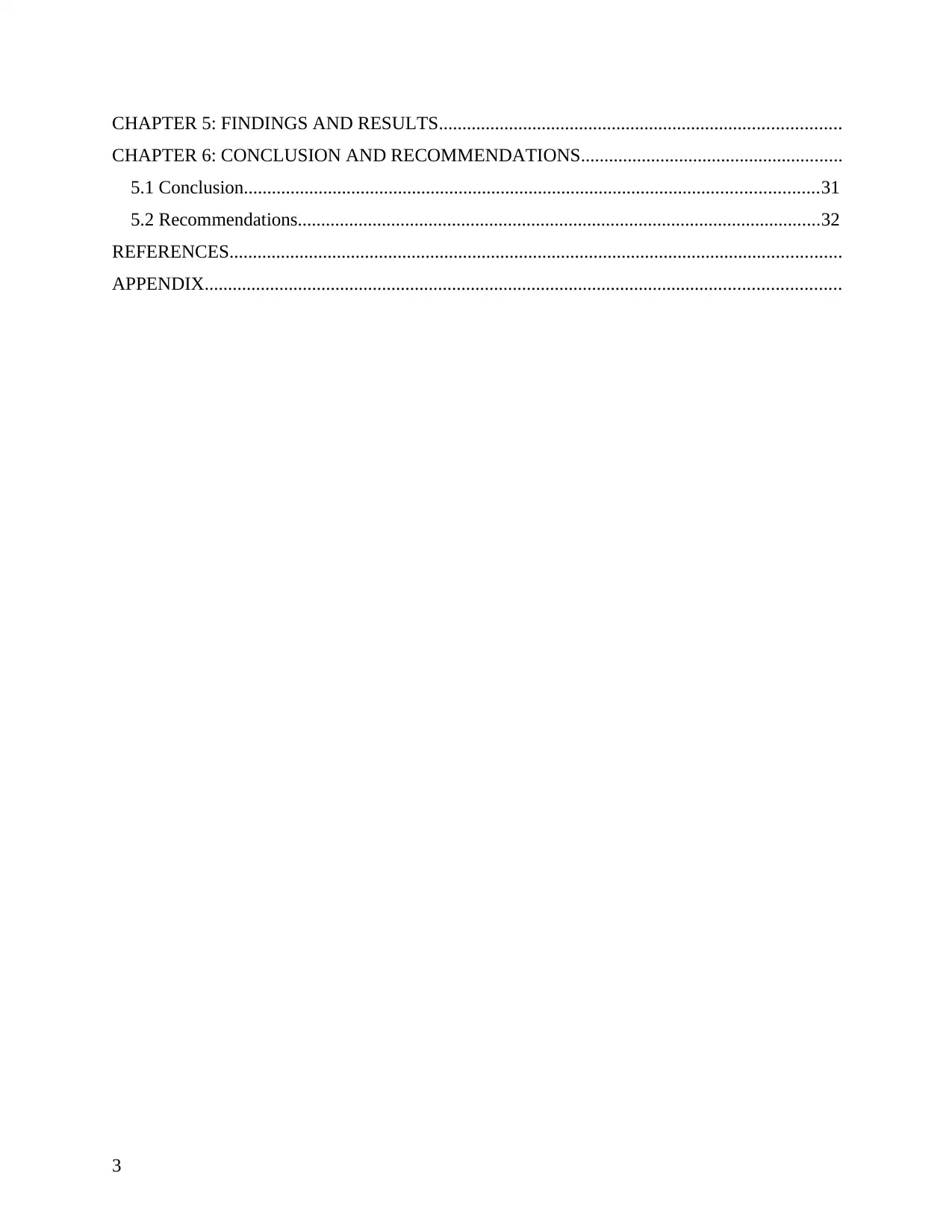
CHAPTER 5: FINDINGS AND RESULTS......................................................................................
CHAPTER 6: CONCLUSION AND RECOMMENDATIONS........................................................
5.1 Conclusion...........................................................................................................................31
5.2 Recommendations................................................................................................................32
REFERENCES...................................................................................................................................
APPENDIX........................................................................................................................................
3
CHAPTER 6: CONCLUSION AND RECOMMENDATIONS........................................................
5.1 Conclusion...........................................................................................................................31
5.2 Recommendations................................................................................................................32
REFERENCES...................................................................................................................................
APPENDIX........................................................................................................................................
3
⊘ This is a preview!⊘
Do you want full access?
Subscribe today to unlock all pages.

Trusted by 1+ million students worldwide
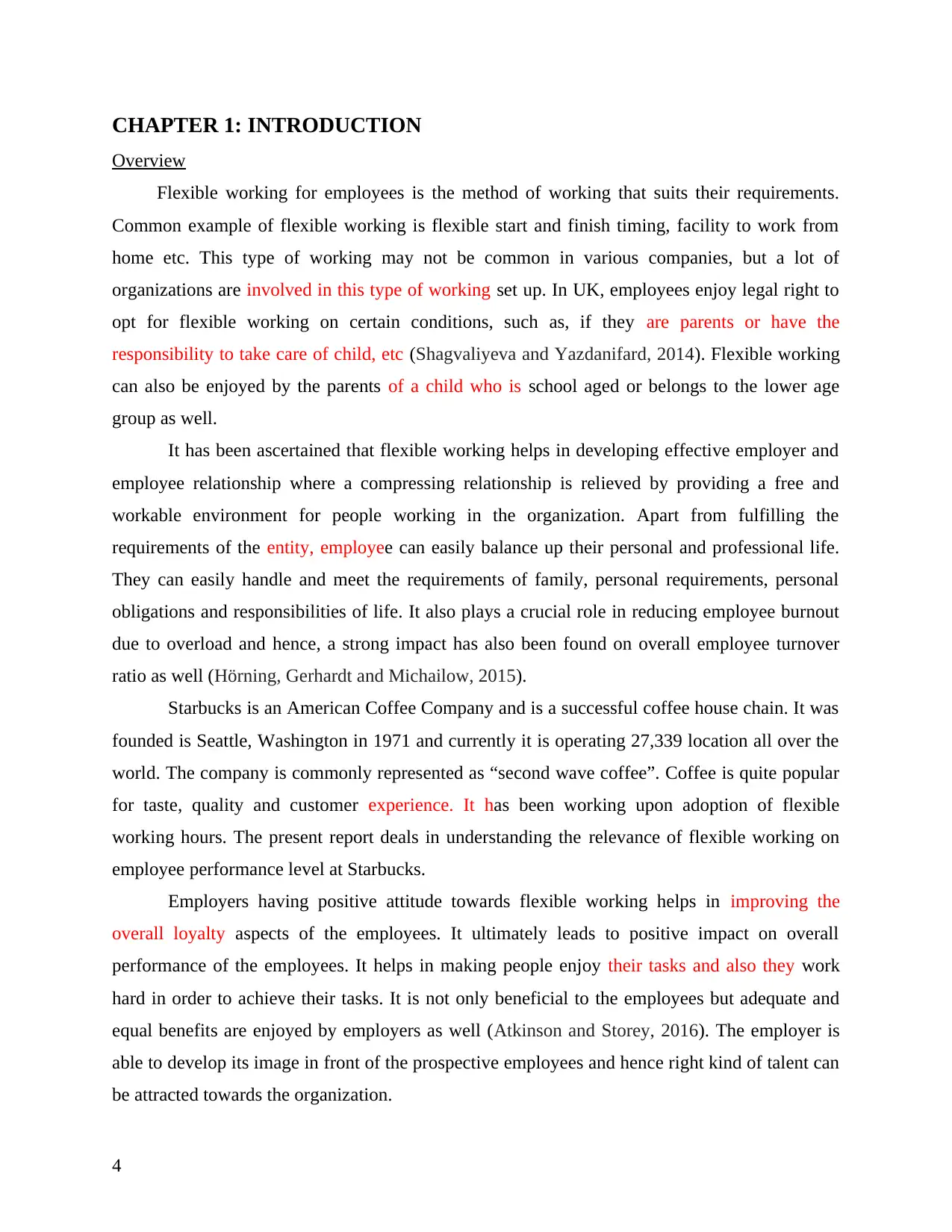
CHAPTER 1: INTRODUCTION
Overview
Flexible working for employees is the method of working that suits their requirements.
Common example of flexible working is flexible start and finish timing, facility to work from
home etc. This type of working may not be common in various companies, but a lot of
organizations are involved in this type of working set up. In UK, employees enjoy legal right to
opt for flexible working on certain conditions, such as, if they are parents or have the
responsibility to take care of child, etc (Shagvaliyeva and Yazdanifard, 2014). Flexible working
can also be enjoyed by the parents of a child who is school aged or belongs to the lower age
group as well.
It has been ascertained that flexible working helps in developing effective employer and
employee relationship where a compressing relationship is relieved by providing a free and
workable environment for people working in the organization. Apart from fulfilling the
requirements of the entity, employee can easily balance up their personal and professional life.
They can easily handle and meet the requirements of family, personal requirements, personal
obligations and responsibilities of life. It also plays a crucial role in reducing employee burnout
due to overload and hence, a strong impact has also been found on overall employee turnover
ratio as well (Hörning, Gerhardt and Michailow, 2015).
Starbucks is an American Coffee Company and is a successful coffee house chain. It was
founded is Seattle, Washington in 1971 and currently it is operating 27,339 location all over the
world. The company is commonly represented as “second wave coffee”. Coffee is quite popular
for taste, quality and customer experience. It has been working upon adoption of flexible
working hours. The present report deals in understanding the relevance of flexible working on
employee performance level at Starbucks.
Employers having positive attitude towards flexible working helps in improving the
overall loyalty aspects of the employees. It ultimately leads to positive impact on overall
performance of the employees. It helps in making people enjoy their tasks and also they work
hard in order to achieve their tasks. It is not only beneficial to the employees but adequate and
equal benefits are enjoyed by employers as well (Atkinson and Storey, 2016). The employer is
able to develop its image in front of the prospective employees and hence right kind of talent can
be attracted towards the organization.
4
Overview
Flexible working for employees is the method of working that suits their requirements.
Common example of flexible working is flexible start and finish timing, facility to work from
home etc. This type of working may not be common in various companies, but a lot of
organizations are involved in this type of working set up. In UK, employees enjoy legal right to
opt for flexible working on certain conditions, such as, if they are parents or have the
responsibility to take care of child, etc (Shagvaliyeva and Yazdanifard, 2014). Flexible working
can also be enjoyed by the parents of a child who is school aged or belongs to the lower age
group as well.
It has been ascertained that flexible working helps in developing effective employer and
employee relationship where a compressing relationship is relieved by providing a free and
workable environment for people working in the organization. Apart from fulfilling the
requirements of the entity, employee can easily balance up their personal and professional life.
They can easily handle and meet the requirements of family, personal requirements, personal
obligations and responsibilities of life. It also plays a crucial role in reducing employee burnout
due to overload and hence, a strong impact has also been found on overall employee turnover
ratio as well (Hörning, Gerhardt and Michailow, 2015).
Starbucks is an American Coffee Company and is a successful coffee house chain. It was
founded is Seattle, Washington in 1971 and currently it is operating 27,339 location all over the
world. The company is commonly represented as “second wave coffee”. Coffee is quite popular
for taste, quality and customer experience. It has been working upon adoption of flexible
working hours. The present report deals in understanding the relevance of flexible working on
employee performance level at Starbucks.
Employers having positive attitude towards flexible working helps in improving the
overall loyalty aspects of the employees. It ultimately leads to positive impact on overall
performance of the employees. It helps in making people enjoy their tasks and also they work
hard in order to achieve their tasks. It is not only beneficial to the employees but adequate and
equal benefits are enjoyed by employers as well (Atkinson and Storey, 2016). The employer is
able to develop its image in front of the prospective employees and hence right kind of talent can
be attracted towards the organization.
4
Paraphrase This Document
Need a fresh take? Get an instant paraphrase of this document with our AI Paraphraser
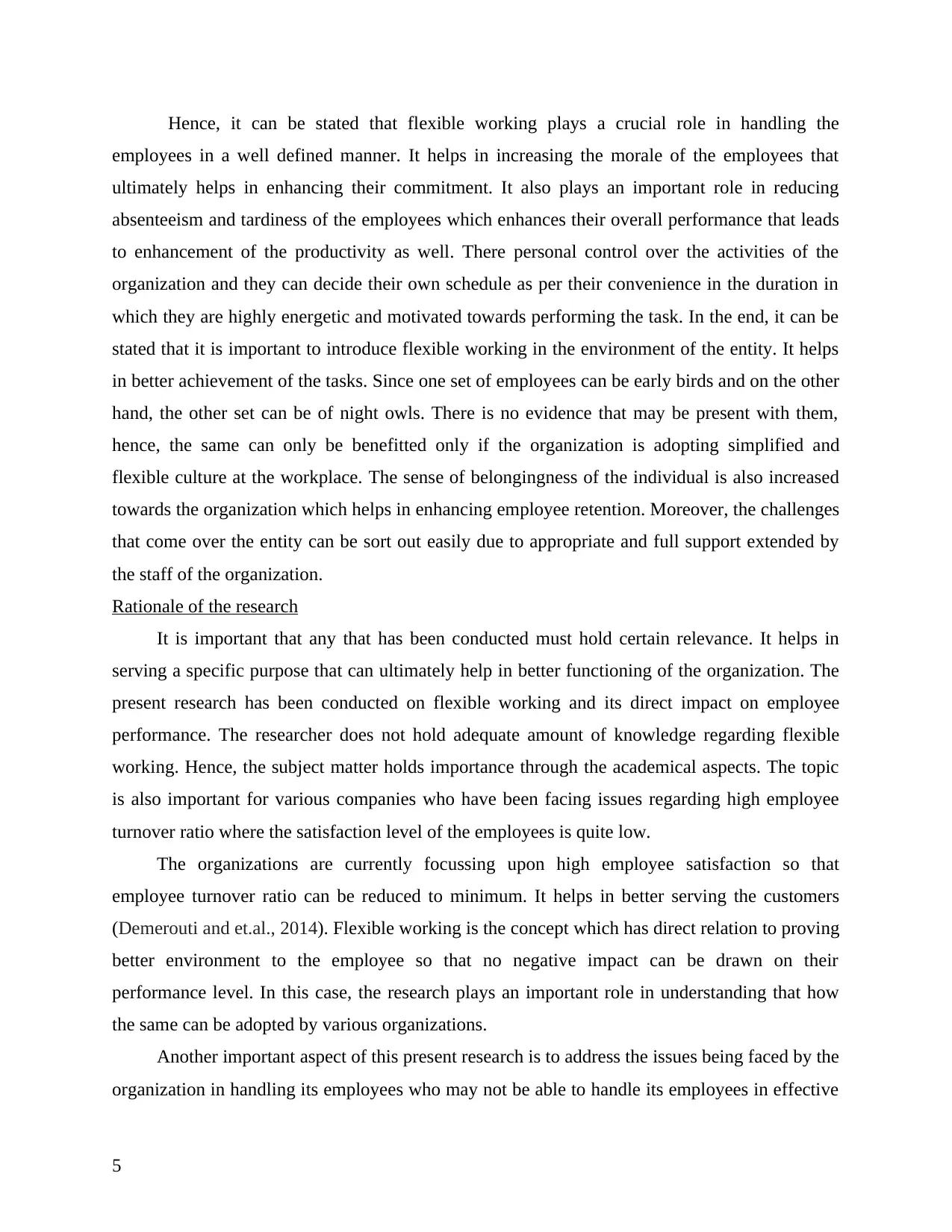
Hence, it can be stated that flexible working plays a crucial role in handling the
employees in a well defined manner. It helps in increasing the morale of the employees that
ultimately helps in enhancing their commitment. It also plays an important role in reducing
absenteeism and tardiness of the employees which enhances their overall performance that leads
to enhancement of the productivity as well. There personal control over the activities of the
organization and they can decide their own schedule as per their convenience in the duration in
which they are highly energetic and motivated towards performing the task. In the end, it can be
stated that it is important to introduce flexible working in the environment of the entity. It helps
in better achievement of the tasks. Since one set of employees can be early birds and on the other
hand, the other set can be of night owls. There is no evidence that may be present with them,
hence, the same can only be benefitted only if the organization is adopting simplified and
flexible culture at the workplace. The sense of belongingness of the individual is also increased
towards the organization which helps in enhancing employee retention. Moreover, the challenges
that come over the entity can be sort out easily due to appropriate and full support extended by
the staff of the organization.
Rationale of the research
It is important that any that has been conducted must hold certain relevance. It helps in
serving a specific purpose that can ultimately help in better functioning of the organization. The
present research has been conducted on flexible working and its direct impact on employee
performance. The researcher does not hold adequate amount of knowledge regarding flexible
working. Hence, the subject matter holds importance through the academical aspects. The topic
is also important for various companies who have been facing issues regarding high employee
turnover ratio where the satisfaction level of the employees is quite low.
The organizations are currently focussing upon high employee satisfaction so that
employee turnover ratio can be reduced to minimum. It helps in better serving the customers
(Demerouti and et.al., 2014). Flexible working is the concept which has direct relation to proving
better environment to the employee so that no negative impact can be drawn on their
performance level. In this case, the research plays an important role in understanding that how
the same can be adopted by various organizations.
Another important aspect of this present research is to address the issues being faced by the
organization in handling its employees who may not be able to handle its employees in effective
5
employees in a well defined manner. It helps in increasing the morale of the employees that
ultimately helps in enhancing their commitment. It also plays an important role in reducing
absenteeism and tardiness of the employees which enhances their overall performance that leads
to enhancement of the productivity as well. There personal control over the activities of the
organization and they can decide their own schedule as per their convenience in the duration in
which they are highly energetic and motivated towards performing the task. In the end, it can be
stated that it is important to introduce flexible working in the environment of the entity. It helps
in better achievement of the tasks. Since one set of employees can be early birds and on the other
hand, the other set can be of night owls. There is no evidence that may be present with them,
hence, the same can only be benefitted only if the organization is adopting simplified and
flexible culture at the workplace. The sense of belongingness of the individual is also increased
towards the organization which helps in enhancing employee retention. Moreover, the challenges
that come over the entity can be sort out easily due to appropriate and full support extended by
the staff of the organization.
Rationale of the research
It is important that any that has been conducted must hold certain relevance. It helps in
serving a specific purpose that can ultimately help in better functioning of the organization. The
present research has been conducted on flexible working and its direct impact on employee
performance. The researcher does not hold adequate amount of knowledge regarding flexible
working. Hence, the subject matter holds importance through the academical aspects. The topic
is also important for various companies who have been facing issues regarding high employee
turnover ratio where the satisfaction level of the employees is quite low.
The organizations are currently focussing upon high employee satisfaction so that
employee turnover ratio can be reduced to minimum. It helps in better serving the customers
(Demerouti and et.al., 2014). Flexible working is the concept which has direct relation to proving
better environment to the employee so that no negative impact can be drawn on their
performance level. In this case, the research plays an important role in understanding that how
the same can be adopted by various organizations.
Another important aspect of this present research is to address the issues being faced by the
organization in handling its employees who may not be able to handle its employees in effective
5
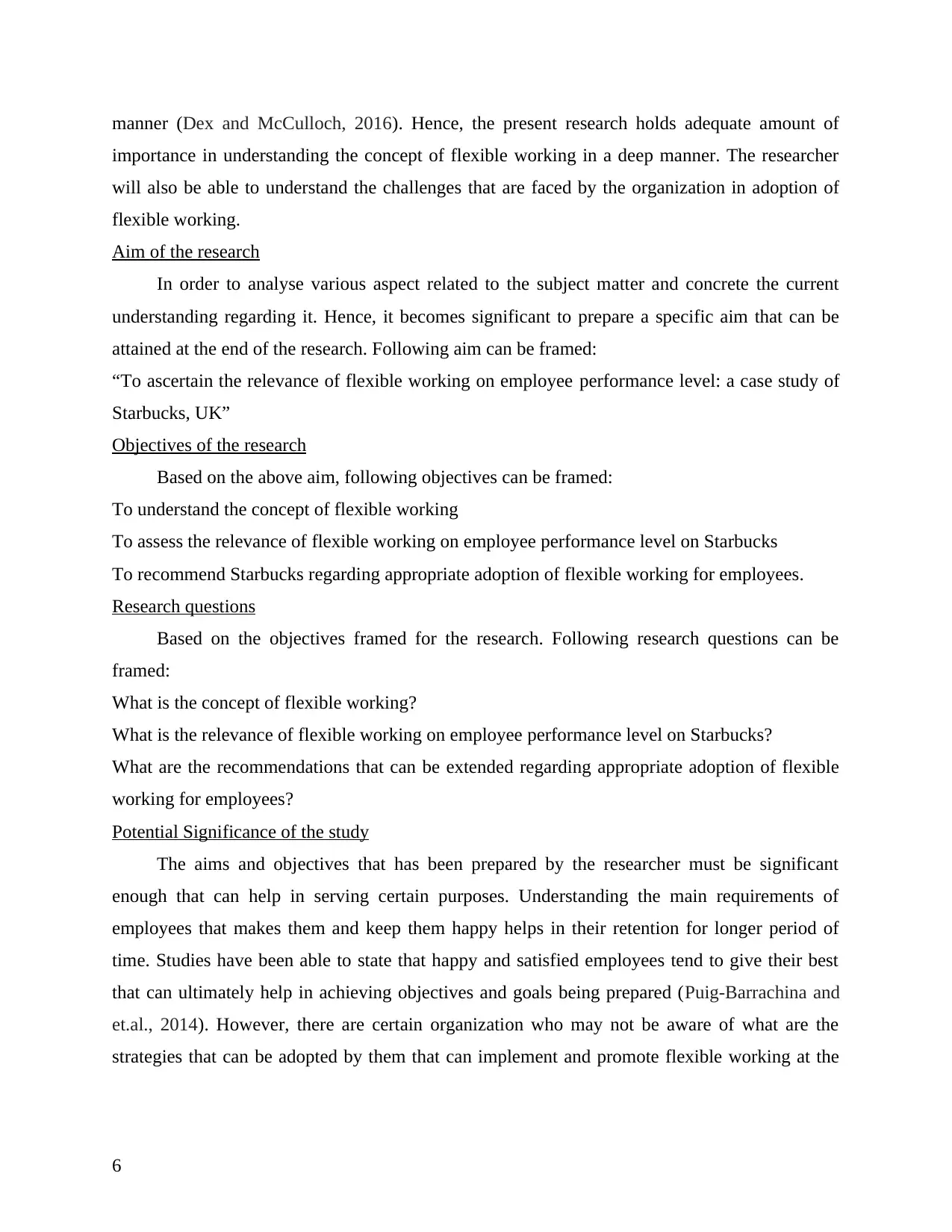
manner (Dex and McCulloch, 2016). Hence, the present research holds adequate amount of
importance in understanding the concept of flexible working in a deep manner. The researcher
will also be able to understand the challenges that are faced by the organization in adoption of
flexible working.
Aim of the research
In order to analyse various aspect related to the subject matter and concrete the current
understanding regarding it. Hence, it becomes significant to prepare a specific aim that can be
attained at the end of the research. Following aim can be framed:
“To ascertain the relevance of flexible working on employee performance level: a case study of
Starbucks, UK”
Objectives of the research
Based on the above aim, following objectives can be framed:
To understand the concept of flexible working
To assess the relevance of flexible working on employee performance level on Starbucks
To recommend Starbucks regarding appropriate adoption of flexible working for employees.
Research questions
Based on the objectives framed for the research. Following research questions can be
framed:
What is the concept of flexible working?
What is the relevance of flexible working on employee performance level on Starbucks?
What are the recommendations that can be extended regarding appropriate adoption of flexible
working for employees?
Potential Significance of the study
The aims and objectives that has been prepared by the researcher must be significant
enough that can help in serving certain purposes. Understanding the main requirements of
employees that makes them and keep them happy helps in their retention for longer period of
time. Studies have been able to state that happy and satisfied employees tend to give their best
that can ultimately help in achieving objectives and goals being prepared (Puig-Barrachina and
et.al., 2014). However, there are certain organization who may not be aware of what are the
strategies that can be adopted by them that can implement and promote flexible working at the
6
importance in understanding the concept of flexible working in a deep manner. The researcher
will also be able to understand the challenges that are faced by the organization in adoption of
flexible working.
Aim of the research
In order to analyse various aspect related to the subject matter and concrete the current
understanding regarding it. Hence, it becomes significant to prepare a specific aim that can be
attained at the end of the research. Following aim can be framed:
“To ascertain the relevance of flexible working on employee performance level: a case study of
Starbucks, UK”
Objectives of the research
Based on the above aim, following objectives can be framed:
To understand the concept of flexible working
To assess the relevance of flexible working on employee performance level on Starbucks
To recommend Starbucks regarding appropriate adoption of flexible working for employees.
Research questions
Based on the objectives framed for the research. Following research questions can be
framed:
What is the concept of flexible working?
What is the relevance of flexible working on employee performance level on Starbucks?
What are the recommendations that can be extended regarding appropriate adoption of flexible
working for employees?
Potential Significance of the study
The aims and objectives that has been prepared by the researcher must be significant
enough that can help in serving certain purposes. Understanding the main requirements of
employees that makes them and keep them happy helps in their retention for longer period of
time. Studies have been able to state that happy and satisfied employees tend to give their best
that can ultimately help in achieving objectives and goals being prepared (Puig-Barrachina and
et.al., 2014). However, there are certain organization who may not be aware of what are the
strategies that can be adopted by them that can implement and promote flexible working at the
6
⊘ This is a preview!⊘
Do you want full access?
Subscribe today to unlock all pages.

Trusted by 1+ million students worldwide
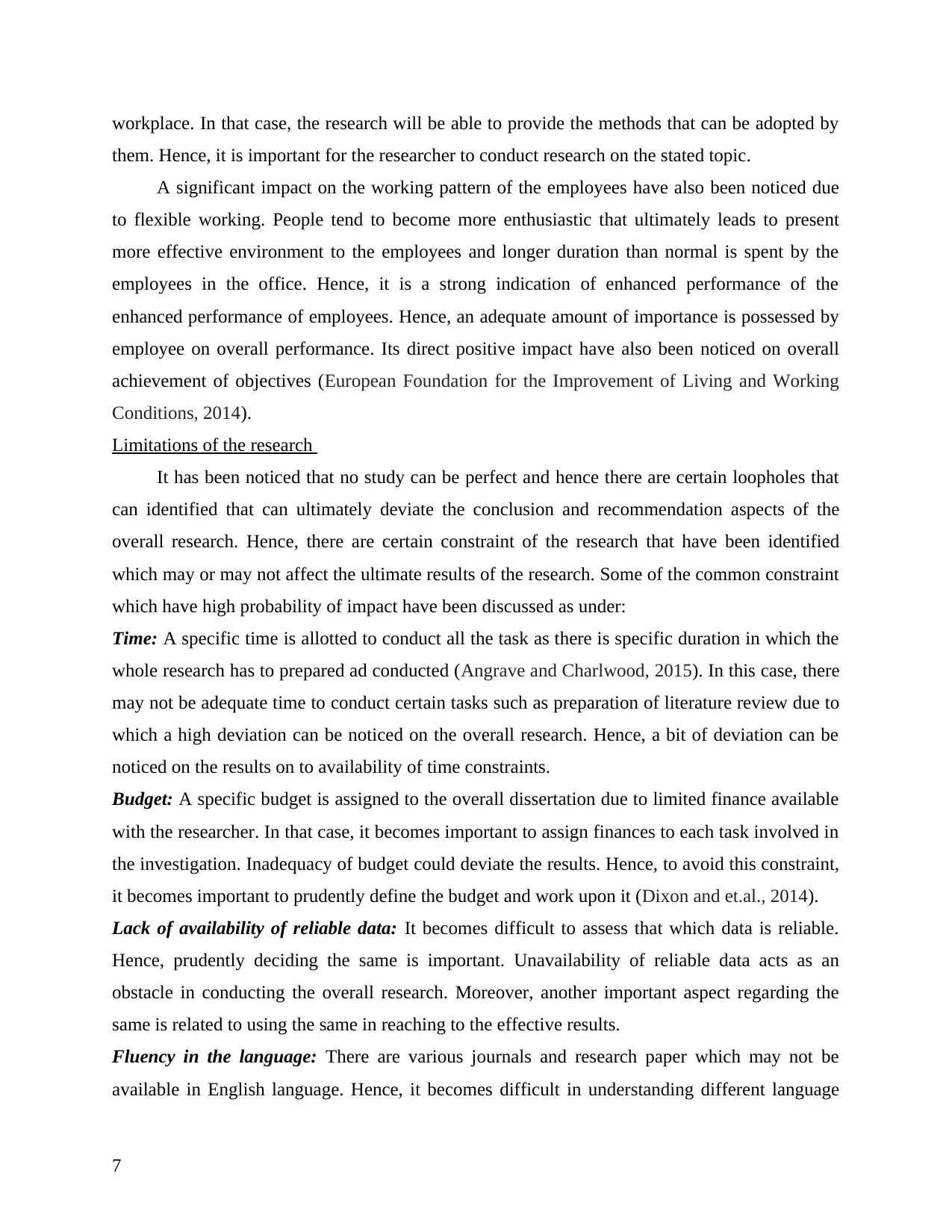
workplace. In that case, the research will be able to provide the methods that can be adopted by
them. Hence, it is important for the researcher to conduct research on the stated topic.
A significant impact on the working pattern of the employees have also been noticed due
to flexible working. People tend to become more enthusiastic that ultimately leads to present
more effective environment to the employees and longer duration than normal is spent by the
employees in the office. Hence, it is a strong indication of enhanced performance of the
enhanced performance of employees. Hence, an adequate amount of importance is possessed by
employee on overall performance. Its direct positive impact have also been noticed on overall
achievement of objectives (European Foundation for the Improvement of Living and Working
Conditions, 2014).
Limitations of the research
It has been noticed that no study can be perfect and hence there are certain loopholes that
can identified that can ultimately deviate the conclusion and recommendation aspects of the
overall research. Hence, there are certain constraint of the research that have been identified
which may or may not affect the ultimate results of the research. Some of the common constraint
which have high probability of impact have been discussed as under:
Time: A specific time is allotted to conduct all the task as there is specific duration in which the
whole research has to prepared ad conducted (Angrave and Charlwood, 2015). In this case, there
may not be adequate time to conduct certain tasks such as preparation of literature review due to
which a high deviation can be noticed on the overall research. Hence, a bit of deviation can be
noticed on the results on to availability of time constraints.
Budget: A specific budget is assigned to the overall dissertation due to limited finance available
with the researcher. In that case, it becomes important to assign finances to each task involved in
the investigation. Inadequacy of budget could deviate the results. Hence, to avoid this constraint,
it becomes important to prudently define the budget and work upon it (Dixon and et.al., 2014).
Lack of availability of reliable data: It becomes difficult to assess that which data is reliable.
Hence, prudently deciding the same is important. Unavailability of reliable data acts as an
obstacle in conducting the overall research. Moreover, another important aspect regarding the
same is related to using the same in reaching to the effective results.
Fluency in the language: There are various journals and research paper which may not be
available in English language. Hence, it becomes difficult in understanding different language
7
them. Hence, it is important for the researcher to conduct research on the stated topic.
A significant impact on the working pattern of the employees have also been noticed due
to flexible working. People tend to become more enthusiastic that ultimately leads to present
more effective environment to the employees and longer duration than normal is spent by the
employees in the office. Hence, it is a strong indication of enhanced performance of the
enhanced performance of employees. Hence, an adequate amount of importance is possessed by
employee on overall performance. Its direct positive impact have also been noticed on overall
achievement of objectives (European Foundation for the Improvement of Living and Working
Conditions, 2014).
Limitations of the research
It has been noticed that no study can be perfect and hence there are certain loopholes that
can identified that can ultimately deviate the conclusion and recommendation aspects of the
overall research. Hence, there are certain constraint of the research that have been identified
which may or may not affect the ultimate results of the research. Some of the common constraint
which have high probability of impact have been discussed as under:
Time: A specific time is allotted to conduct all the task as there is specific duration in which the
whole research has to prepared ad conducted (Angrave and Charlwood, 2015). In this case, there
may not be adequate time to conduct certain tasks such as preparation of literature review due to
which a high deviation can be noticed on the overall research. Hence, a bit of deviation can be
noticed on the results on to availability of time constraints.
Budget: A specific budget is assigned to the overall dissertation due to limited finance available
with the researcher. In that case, it becomes important to assign finances to each task involved in
the investigation. Inadequacy of budget could deviate the results. Hence, to avoid this constraint,
it becomes important to prudently define the budget and work upon it (Dixon and et.al., 2014).
Lack of availability of reliable data: It becomes difficult to assess that which data is reliable.
Hence, prudently deciding the same is important. Unavailability of reliable data acts as an
obstacle in conducting the overall research. Moreover, another important aspect regarding the
same is related to using the same in reaching to the effective results.
Fluency in the language: There are various journals and research paper which may not be
available in English language. Hence, it becomes difficult in understanding different language
7
Paraphrase This Document
Need a fresh take? Get an instant paraphrase of this document with our AI Paraphraser
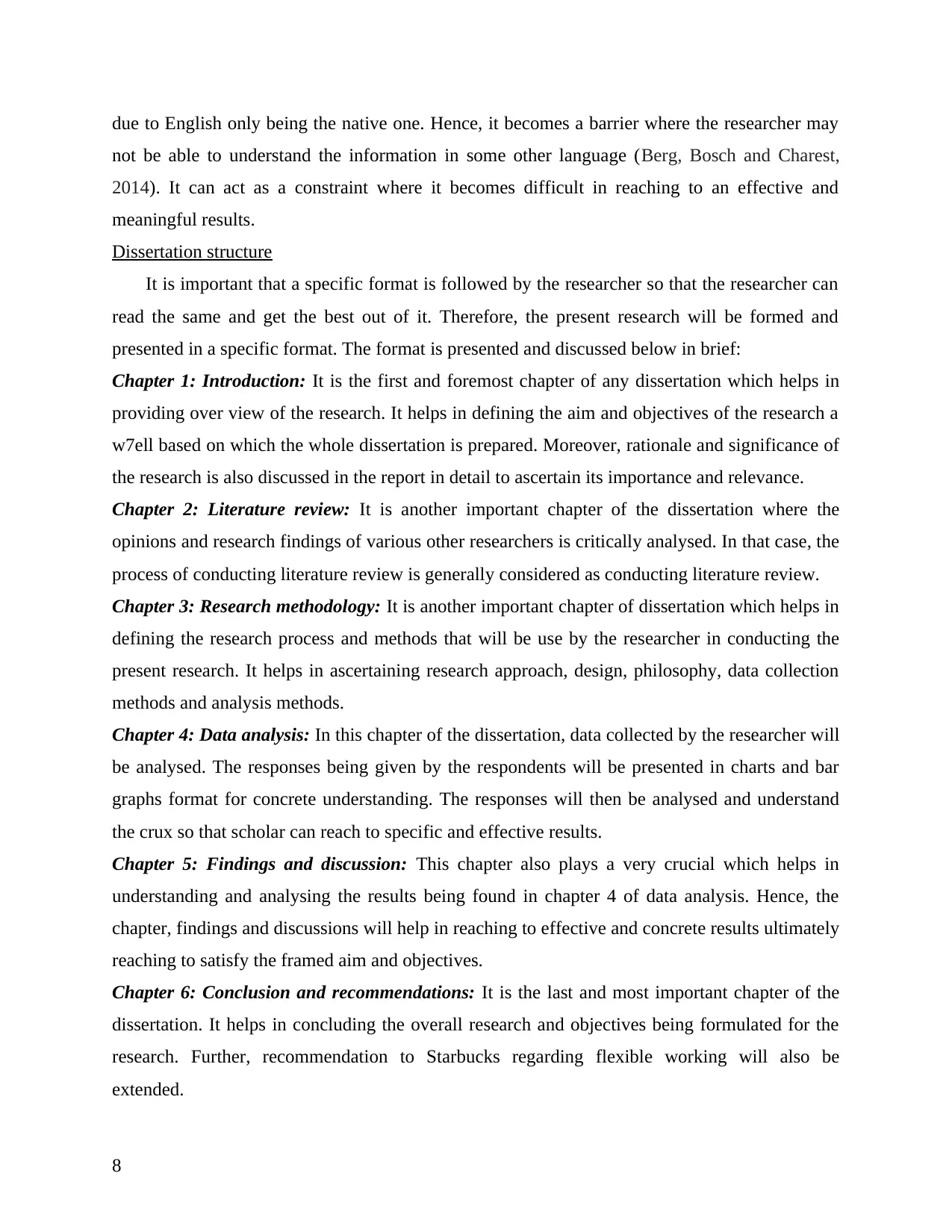
due to English only being the native one. Hence, it becomes a barrier where the researcher may
not be able to understand the information in some other language (Berg, Bosch and Charest,
2014). It can act as a constraint where it becomes difficult in reaching to an effective and
meaningful results.
Dissertation structure
It is important that a specific format is followed by the researcher so that the researcher can
read the same and get the best out of it. Therefore, the present research will be formed and
presented in a specific format. The format is presented and discussed below in brief:
Chapter 1: Introduction: It is the first and foremost chapter of any dissertation which helps in
providing over view of the research. It helps in defining the aim and objectives of the research a
w7ell based on which the whole dissertation is prepared. Moreover, rationale and significance of
the research is also discussed in the report in detail to ascertain its importance and relevance.
Chapter 2: Literature review: It is another important chapter of the dissertation where the
opinions and research findings of various other researchers is critically analysed. In that case, the
process of conducting literature review is generally considered as conducting literature review.
Chapter 3: Research methodology: It is another important chapter of dissertation which helps in
defining the research process and methods that will be use by the researcher in conducting the
present research. It helps in ascertaining research approach, design, philosophy, data collection
methods and analysis methods.
Chapter 4: Data analysis: In this chapter of the dissertation, data collected by the researcher will
be analysed. The responses being given by the respondents will be presented in charts and bar
graphs format for concrete understanding. The responses will then be analysed and understand
the crux so that scholar can reach to specific and effective results.
Chapter 5: Findings and discussion: This chapter also plays a very crucial which helps in
understanding and analysing the results being found in chapter 4 of data analysis. Hence, the
chapter, findings and discussions will help in reaching to effective and concrete results ultimately
reaching to satisfy the framed aim and objectives.
Chapter 6: Conclusion and recommendations: It is the last and most important chapter of the
dissertation. It helps in concluding the overall research and objectives being formulated for the
research. Further, recommendation to Starbucks regarding flexible working will also be
extended.
8
not be able to understand the information in some other language (Berg, Bosch and Charest,
2014). It can act as a constraint where it becomes difficult in reaching to an effective and
meaningful results.
Dissertation structure
It is important that a specific format is followed by the researcher so that the researcher can
read the same and get the best out of it. Therefore, the present research will be formed and
presented in a specific format. The format is presented and discussed below in brief:
Chapter 1: Introduction: It is the first and foremost chapter of any dissertation which helps in
providing over view of the research. It helps in defining the aim and objectives of the research a
w7ell based on which the whole dissertation is prepared. Moreover, rationale and significance of
the research is also discussed in the report in detail to ascertain its importance and relevance.
Chapter 2: Literature review: It is another important chapter of the dissertation where the
opinions and research findings of various other researchers is critically analysed. In that case, the
process of conducting literature review is generally considered as conducting literature review.
Chapter 3: Research methodology: It is another important chapter of dissertation which helps in
defining the research process and methods that will be use by the researcher in conducting the
present research. It helps in ascertaining research approach, design, philosophy, data collection
methods and analysis methods.
Chapter 4: Data analysis: In this chapter of the dissertation, data collected by the researcher will
be analysed. The responses being given by the respondents will be presented in charts and bar
graphs format for concrete understanding. The responses will then be analysed and understand
the crux so that scholar can reach to specific and effective results.
Chapter 5: Findings and discussion: This chapter also plays a very crucial which helps in
understanding and analysing the results being found in chapter 4 of data analysis. Hence, the
chapter, findings and discussions will help in reaching to effective and concrete results ultimately
reaching to satisfy the framed aim and objectives.
Chapter 6: Conclusion and recommendations: It is the last and most important chapter of the
dissertation. It helps in concluding the overall research and objectives being formulated for the
research. Further, recommendation to Starbucks regarding flexible working will also be
extended.
8
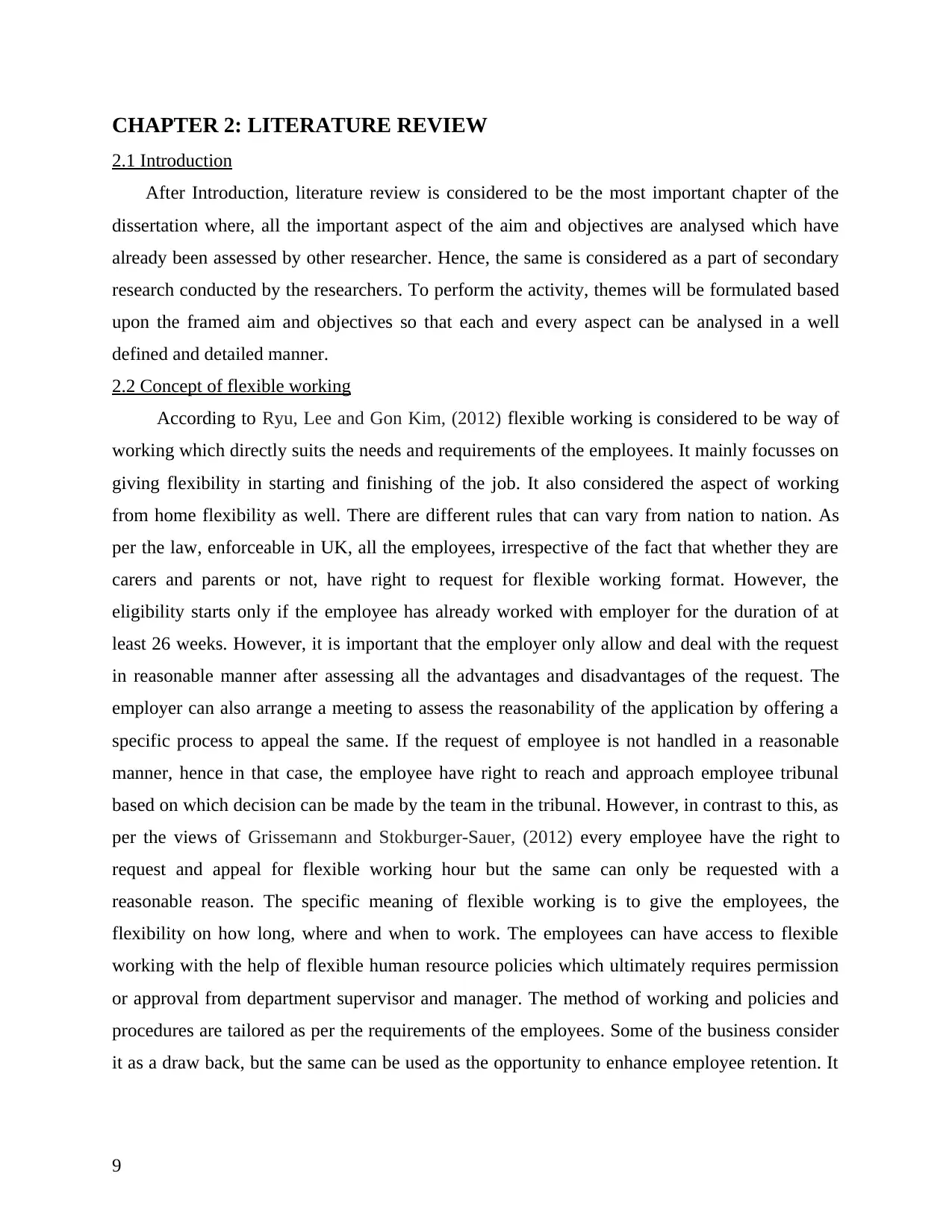
CHAPTER 2: LITERATURE REVIEW
2.1 Introduction
After Introduction, literature review is considered to be the most important chapter of the
dissertation where, all the important aspect of the aim and objectives are analysed which have
already been assessed by other researcher. Hence, the same is considered as a part of secondary
research conducted by the researchers. To perform the activity, themes will be formulated based
upon the framed aim and objectives so that each and every aspect can be analysed in a well
defined and detailed manner.
2.2 Concept of flexible working
According to Ryu, Lee and Gon Kim, (2012) flexible working is considered to be way of
working which directly suits the needs and requirements of the employees. It mainly focusses on
giving flexibility in starting and finishing of the job. It also considered the aspect of working
from home flexibility as well. There are different rules that can vary from nation to nation. As
per the law, enforceable in UK, all the employees, irrespective of the fact that whether they are
carers and parents or not, have right to request for flexible working format. However, the
eligibility starts only if the employee has already worked with employer for the duration of at
least 26 weeks. However, it is important that the employer only allow and deal with the request
in reasonable manner after assessing all the advantages and disadvantages of the request. The
employer can also arrange a meeting to assess the reasonability of the application by offering a
specific process to appeal the same. If the request of employee is not handled in a reasonable
manner, hence in that case, the employee have right to reach and approach employee tribunal
based on which decision can be made by the team in the tribunal. However, in contrast to this, as
per the views of Grissemann and Stokburger-Sauer, (2012) every employee have the right to
request and appeal for flexible working hour but the same can only be requested with a
reasonable reason. The specific meaning of flexible working is to give the employees, the
flexibility on how long, where and when to work. The employees can have access to flexible
working with the help of flexible human resource policies which ultimately requires permission
or approval from department supervisor and manager. The method of working and policies and
procedures are tailored as per the requirements of the employees. Some of the business consider
it as a draw back, but the same can be used as the opportunity to enhance employee retention. It
9
2.1 Introduction
After Introduction, literature review is considered to be the most important chapter of the
dissertation where, all the important aspect of the aim and objectives are analysed which have
already been assessed by other researcher. Hence, the same is considered as a part of secondary
research conducted by the researchers. To perform the activity, themes will be formulated based
upon the framed aim and objectives so that each and every aspect can be analysed in a well
defined and detailed manner.
2.2 Concept of flexible working
According to Ryu, Lee and Gon Kim, (2012) flexible working is considered to be way of
working which directly suits the needs and requirements of the employees. It mainly focusses on
giving flexibility in starting and finishing of the job. It also considered the aspect of working
from home flexibility as well. There are different rules that can vary from nation to nation. As
per the law, enforceable in UK, all the employees, irrespective of the fact that whether they are
carers and parents or not, have right to request for flexible working format. However, the
eligibility starts only if the employee has already worked with employer for the duration of at
least 26 weeks. However, it is important that the employer only allow and deal with the request
in reasonable manner after assessing all the advantages and disadvantages of the request. The
employer can also arrange a meeting to assess the reasonability of the application by offering a
specific process to appeal the same. If the request of employee is not handled in a reasonable
manner, hence in that case, the employee have right to reach and approach employee tribunal
based on which decision can be made by the team in the tribunal. However, in contrast to this, as
per the views of Grissemann and Stokburger-Sauer, (2012) every employee have the right to
request and appeal for flexible working hour but the same can only be requested with a
reasonable reason. The specific meaning of flexible working is to give the employees, the
flexibility on how long, where and when to work. The employees can have access to flexible
working with the help of flexible human resource policies which ultimately requires permission
or approval from department supervisor and manager. The method of working and policies and
procedures are tailored as per the requirements of the employees. Some of the business consider
it as a draw back, but the same can be used as the opportunity to enhance employee retention. It
9
⊘ This is a preview!⊘
Do you want full access?
Subscribe today to unlock all pages.

Trusted by 1+ million students worldwide
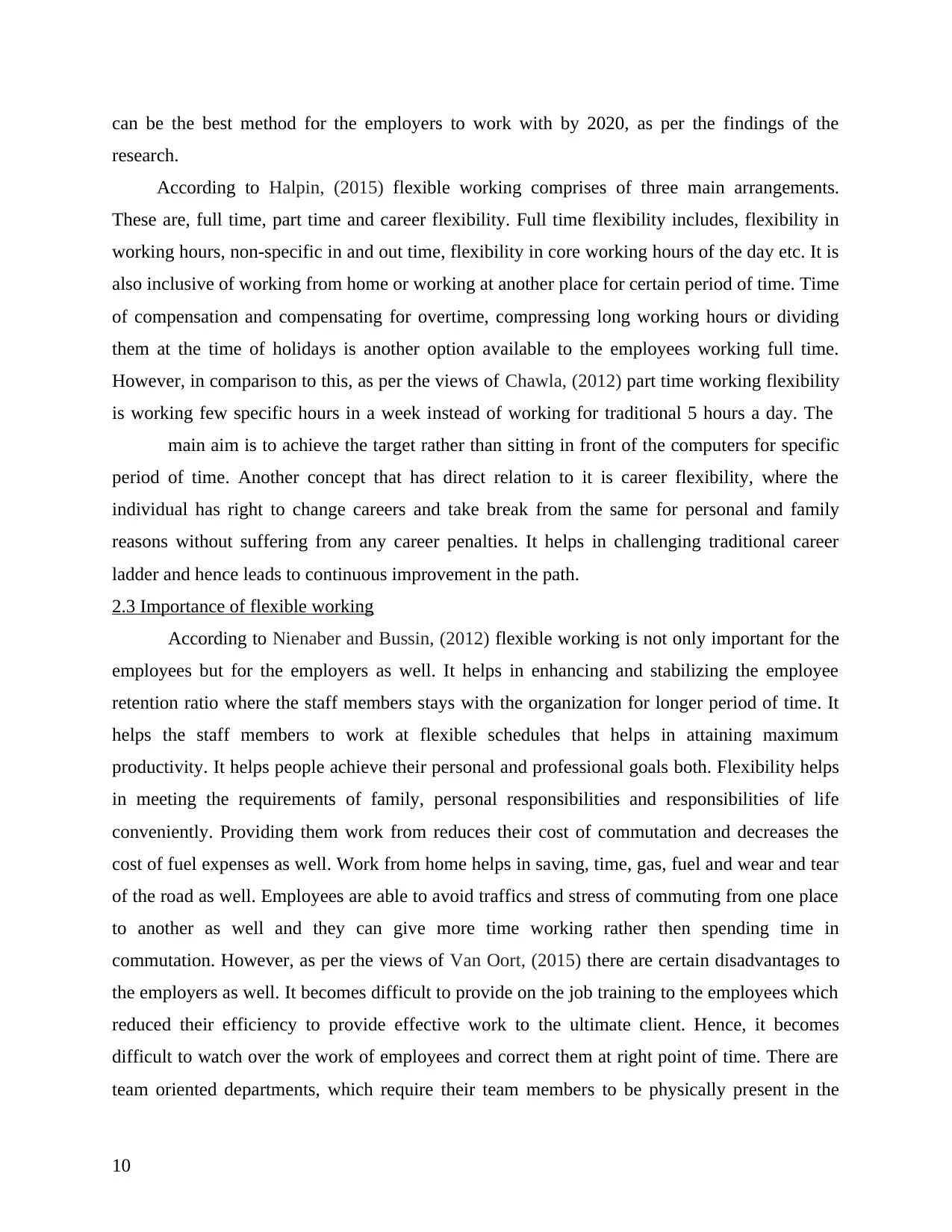
can be the best method for the employers to work with by 2020, as per the findings of the
research.
According to Halpin, (2015) flexible working comprises of three main arrangements.
These are, full time, part time and career flexibility. Full time flexibility includes, flexibility in
working hours, non-specific in and out time, flexibility in core working hours of the day etc. It is
also inclusive of working from home or working at another place for certain period of time. Time
of compensation and compensating for overtime, compressing long working hours or dividing
them at the time of holidays is another option available to the employees working full time.
However, in comparison to this, as per the views of Chawla, (2012) part time working flexibility
is working few specific hours in a week instead of working for traditional 5 hours a day. The
main aim is to achieve the target rather than sitting in front of the computers for specific
period of time. Another concept that has direct relation to it is career flexibility, where the
individual has right to change careers and take break from the same for personal and family
reasons without suffering from any career penalties. It helps in challenging traditional career
ladder and hence leads to continuous improvement in the path.
2.3 Importance of flexible working
According to Nienaber and Bussin, (2012) flexible working is not only important for the
employees but for the employers as well. It helps in enhancing and stabilizing the employee
retention ratio where the staff members stays with the organization for longer period of time. It
helps the staff members to work at flexible schedules that helps in attaining maximum
productivity. It helps people achieve their personal and professional goals both. Flexibility helps
in meeting the requirements of family, personal responsibilities and responsibilities of life
conveniently. Providing them work from reduces their cost of commutation and decreases the
cost of fuel expenses as well. Work from home helps in saving, time, gas, fuel and wear and tear
of the road as well. Employees are able to avoid traffics and stress of commuting from one place
to another as well and they can give more time working rather then spending time in
commutation. However, as per the views of Van Oort, (2015) there are certain disadvantages to
the employers as well. It becomes difficult to provide on the job training to the employees which
reduced their efficiency to provide effective work to the ultimate client. Hence, it becomes
difficult to watch over the work of employees and correct them at right point of time. There are
team oriented departments, which require their team members to be physically present in the
10
research.
According to Halpin, (2015) flexible working comprises of three main arrangements.
These are, full time, part time and career flexibility. Full time flexibility includes, flexibility in
working hours, non-specific in and out time, flexibility in core working hours of the day etc. It is
also inclusive of working from home or working at another place for certain period of time. Time
of compensation and compensating for overtime, compressing long working hours or dividing
them at the time of holidays is another option available to the employees working full time.
However, in comparison to this, as per the views of Chawla, (2012) part time working flexibility
is working few specific hours in a week instead of working for traditional 5 hours a day. The
main aim is to achieve the target rather than sitting in front of the computers for specific
period of time. Another concept that has direct relation to it is career flexibility, where the
individual has right to change careers and take break from the same for personal and family
reasons without suffering from any career penalties. It helps in challenging traditional career
ladder and hence leads to continuous improvement in the path.
2.3 Importance of flexible working
According to Nienaber and Bussin, (2012) flexible working is not only important for the
employees but for the employers as well. It helps in enhancing and stabilizing the employee
retention ratio where the staff members stays with the organization for longer period of time. It
helps the staff members to work at flexible schedules that helps in attaining maximum
productivity. It helps people achieve their personal and professional goals both. Flexibility helps
in meeting the requirements of family, personal responsibilities and responsibilities of life
conveniently. Providing them work from reduces their cost of commutation and decreases the
cost of fuel expenses as well. Work from home helps in saving, time, gas, fuel and wear and tear
of the road as well. Employees are able to avoid traffics and stress of commuting from one place
to another as well and they can give more time working rather then spending time in
commutation. However, as per the views of Van Oort, (2015) there are certain disadvantages to
the employers as well. It becomes difficult to provide on the job training to the employees which
reduced their efficiency to provide effective work to the ultimate client. Hence, it becomes
difficult to watch over the work of employees and correct them at right point of time. There are
team oriented departments, which require their team members to be physically present in the
10
Paraphrase This Document
Need a fresh take? Get an instant paraphrase of this document with our AI Paraphraser

office rather than sitting at home. It becomes difficult to work with people opting for flexible
working. It also becomes difficult to judge their productivity at the end.
According to Jianfei, (2014) flexible working helps in enhancing the personal control
over the work It also helps in scheduling the day according to it which make the environment
workable for the employees. They can prepare their own schedule which makes them
comfortable and maintain their zest and enthusiasm to work. It also helps in developing a good
image of the employer as well due to flexible working schedules. There are various
organizational challenges that come up over the entity, which can only be resolved with the help
and support of the staff members. In that case, providing flexible working helps in giving them
an edge where they tend to support the management. However, in contrast to this, as per the
views of Agger, (2015) it becomes difficult for the managers to work based upon the new
management style. They need to change their management perspectives and the way they handle
their subordinates with the adoption of new management styles. It requires trust and training of
top level management as well. There is certain business which requires their client to be present
at least 5 days and 9 hours a week so as to effectively solve out their queries. It becomes easy to
handle them which may not be easy if flexible working is adopted by the management of the
company. Moreover, in addition to this, some jobs may require customer facing where the
presence of the employees becomes crucial. In that case, working from home for the whole day
is not an option. Hence, it becomes difficult for them to adopt the management and handling
style of flexible working. There fore, it may not be suited for all the companies.
2.4 Importance of employees’ performance level
According to Camuffo and De Stefano, (2016) employee’s performance level plays an
important role in laddering the organization towards success. Employees are considered to be a n
important asset of the organization where they are considered to be the people who are
responsible to provide end people who are directly connected to the customers. They are the
people who are the key to success of the organization. Employers are required to keep their
employees content and motivated enough that can help in fulfilling the requirements and
objectives of the organization. Employees are able to manage the output and productivity of the
entity as they have important role in managing the performance of the business. They also play
crucial role in increasing profits and consistently meeting the requirements and goals of sales.
However, in comparison to this, asper the views of Hou and Yang, (2014) employees are
11
working. It also becomes difficult to judge their productivity at the end.
According to Jianfei, (2014) flexible working helps in enhancing the personal control
over the work It also helps in scheduling the day according to it which make the environment
workable for the employees. They can prepare their own schedule which makes them
comfortable and maintain their zest and enthusiasm to work. It also helps in developing a good
image of the employer as well due to flexible working schedules. There are various
organizational challenges that come up over the entity, which can only be resolved with the help
and support of the staff members. In that case, providing flexible working helps in giving them
an edge where they tend to support the management. However, in contrast to this, as per the
views of Agger, (2015) it becomes difficult for the managers to work based upon the new
management style. They need to change their management perspectives and the way they handle
their subordinates with the adoption of new management styles. It requires trust and training of
top level management as well. There is certain business which requires their client to be present
at least 5 days and 9 hours a week so as to effectively solve out their queries. It becomes easy to
handle them which may not be easy if flexible working is adopted by the management of the
company. Moreover, in addition to this, some jobs may require customer facing where the
presence of the employees becomes crucial. In that case, working from home for the whole day
is not an option. Hence, it becomes difficult for them to adopt the management and handling
style of flexible working. There fore, it may not be suited for all the companies.
2.4 Importance of employees’ performance level
According to Camuffo and De Stefano, (2016) employee’s performance level plays an
important role in laddering the organization towards success. Employees are considered to be a n
important asset of the organization where they are considered to be the people who are
responsible to provide end people who are directly connected to the customers. They are the
people who are the key to success of the organization. Employers are required to keep their
employees content and motivated enough that can help in fulfilling the requirements and
objectives of the organization. Employees are able to manage the output and productivity of the
entity as they have important role in managing the performance of the business. They also play
crucial role in increasing profits and consistently meeting the requirements and goals of sales.
However, in comparison to this, asper the views of Hou and Yang, (2014) employees are
11
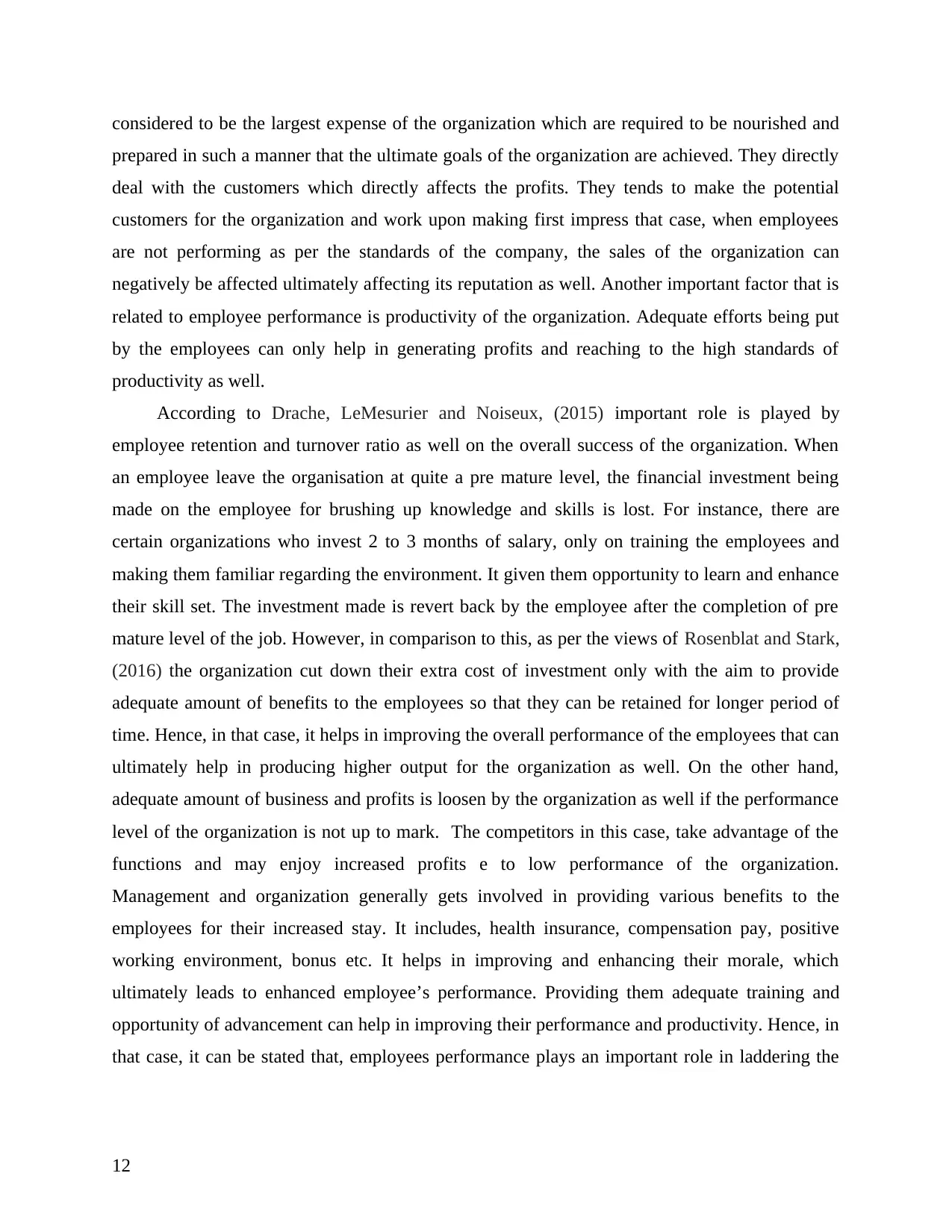
considered to be the largest expense of the organization which are required to be nourished and
prepared in such a manner that the ultimate goals of the organization are achieved. They directly
deal with the customers which directly affects the profits. They tends to make the potential
customers for the organization and work upon making first impress that case, when employees
are not performing as per the standards of the company, the sales of the organization can
negatively be affected ultimately affecting its reputation as well. Another important factor that is
related to employee performance is productivity of the organization. Adequate efforts being put
by the employees can only help in generating profits and reaching to the high standards of
productivity as well.
According to Drache, LeMesurier and Noiseux, (2015) important role is played by
employee retention and turnover ratio as well on the overall success of the organization. When
an employee leave the organisation at quite a pre mature level, the financial investment being
made on the employee for brushing up knowledge and skills is lost. For instance, there are
certain organizations who invest 2 to 3 months of salary, only on training the employees and
making them familiar regarding the environment. It given them opportunity to learn and enhance
their skill set. The investment made is revert back by the employee after the completion of pre
mature level of the job. However, in comparison to this, as per the views of Rosenblat and Stark,
(2016) the organization cut down their extra cost of investment only with the aim to provide
adequate amount of benefits to the employees so that they can be retained for longer period of
time. Hence, in that case, it helps in improving the overall performance of the employees that can
ultimately help in producing higher output for the organization as well. On the other hand,
adequate amount of business and profits is loosen by the organization as well if the performance
level of the organization is not up to mark. The competitors in this case, take advantage of the
functions and may enjoy increased profits e to low performance of the organization.
Management and organization generally gets involved in providing various benefits to the
employees for their increased stay. It includes, health insurance, compensation pay, positive
working environment, bonus etc. It helps in improving and enhancing their morale, which
ultimately leads to enhanced employee’s performance. Providing them adequate training and
opportunity of advancement can help in improving their performance and productivity. Hence, in
that case, it can be stated that, employees performance plays an important role in laddering the
12
prepared in such a manner that the ultimate goals of the organization are achieved. They directly
deal with the customers which directly affects the profits. They tends to make the potential
customers for the organization and work upon making first impress that case, when employees
are not performing as per the standards of the company, the sales of the organization can
negatively be affected ultimately affecting its reputation as well. Another important factor that is
related to employee performance is productivity of the organization. Adequate efforts being put
by the employees can only help in generating profits and reaching to the high standards of
productivity as well.
According to Drache, LeMesurier and Noiseux, (2015) important role is played by
employee retention and turnover ratio as well on the overall success of the organization. When
an employee leave the organisation at quite a pre mature level, the financial investment being
made on the employee for brushing up knowledge and skills is lost. For instance, there are
certain organizations who invest 2 to 3 months of salary, only on training the employees and
making them familiar regarding the environment. It given them opportunity to learn and enhance
their skill set. The investment made is revert back by the employee after the completion of pre
mature level of the job. However, in comparison to this, as per the views of Rosenblat and Stark,
(2016) the organization cut down their extra cost of investment only with the aim to provide
adequate amount of benefits to the employees so that they can be retained for longer period of
time. Hence, in that case, it helps in improving the overall performance of the employees that can
ultimately help in producing higher output for the organization as well. On the other hand,
adequate amount of business and profits is loosen by the organization as well if the performance
level of the organization is not up to mark. The competitors in this case, take advantage of the
functions and may enjoy increased profits e to low performance of the organization.
Management and organization generally gets involved in providing various benefits to the
employees for their increased stay. It includes, health insurance, compensation pay, positive
working environment, bonus etc. It helps in improving and enhancing their morale, which
ultimately leads to enhanced employee’s performance. Providing them adequate training and
opportunity of advancement can help in improving their performance and productivity. Hence, in
that case, it can be stated that, employees performance plays an important role in laddering the
12
⊘ This is a preview!⊘
Do you want full access?
Subscribe today to unlock all pages.

Trusted by 1+ million students worldwide
1 out of 39
Related Documents
Your All-in-One AI-Powered Toolkit for Academic Success.
+13062052269
info@desklib.com
Available 24*7 on WhatsApp / Email
![[object Object]](/_next/static/media/star-bottom.7253800d.svg)
Unlock your academic potential
Copyright © 2020–2025 A2Z Services. All Rights Reserved. Developed and managed by ZUCOL.





